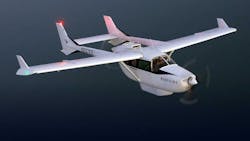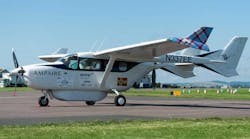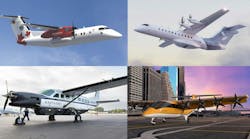An Introduction to Hybrid-Electric Aircraft (Part 1)
Members can download this article in PDF format.
What you’ll learn:
- How hybrid-electric aircraft can cut CO2 emissions by 50% or more along with offering dramatically lower operating costs.
- Low power densities of today's batteries make all-electric flight impractical for most applications—how does hybrid-electric propulsion offer an alternative solution that also accelerates the development of the technologies leading to pure electric flight.
- Companies that already have hybrid-powered commercial passenger aircraft under development.
For Part 2 of this series, click here.
The process of electrifying the world's fleet of cargo and passenger aircraft appears to have begun. It will most likely occur in a series of evolutionary phases, each lasting multiple decades (Fig. 1). Due to the limitations of today's batteries and the conservative nature of the aircraft industry, it's expected that most of the next decade's commercial developments will focus on various types of hybrid-electric propulsion systems.
Driven by various combinations of batteries and conventional power plants, hybrid aircraft are already demonstrating their potential to both reduce carbon emissions and help support the development of the technologies required to support practical all-electric fleets.
As we shall see, even this relatively gradual transition to electrified flight will present several major technical challenges and offer some even greater potential rewards for both aircraft manufacturers and operators. (Please also note that this article will not include much mention of the recent crop of all-electric vertical take-off and landing, or eVTOL, and other personal electric air vehicles that have captured the public's imagination because they belong to a completely different category and deserve their own story.)
Hybrid-Electric Aircraft Impact on Climate Change
Although aviation is estimated to account for only about 2% of today's global carbon emissions, the speed, convenience, and value that air transport brings to our swift-moving economy is expected to drive its growth by between 300% and 700% by 2030.1 Without intervention, this could make aviation a major climate-influencer, especially as the rest of the economy's transition to low/no-carbon energy sources makes it an even larger fraction of our total greenhouse emissions.
Surprisingly, though, the economics of electric aviation may be an even more compelling reason for companies to embrace the transition. While electric propulsion does offer potentially lower fuel costs,* operators may realize equal or greater savings thanks to their dramatically lower engine maintenance and overhaul costs versus the engines that power today's commercial aircraft.
While jet and turboprop engines are extremely reliable and have very long service lives, their repair and overhaul costs comprise a major fraction of an aircraft's operating expenses. Consider, for example, the venerable Pratt and Whitney PT-6A-20 turboshaft engine that powers a large portion of the world's light transport aircraft. It has an expected time between overhauls (TBOs) of 3,600 hours, with routine maintenance, mid-life inspection, and overhaul costs for that period typically running $400K to $600K, or $110-$170/hour (or more).
>>Check out the other parts of this series
The larger turbofan engines found in modern airliners have TBOs that range between 4,000 and 6,000 hours and have proportionately larger maintenance and overhaul costs that typically constitute their second- or third-largest operational expense.
And while the hard numbers related to the engine maintenance and overhaul costs for large airliners are difficult to come by, we can get a sense of the magnitudes involved from the cost of operating a Bombardier Global 6000, a 17-passenger business jet. It turns out that the $1,870 per hour that must be set aside for engine replacement or overhaul (excluding routine maintenance) comes close to the $2,000 to $2,500 worth of fuel it burns in the same period.
In comparison, the relatively simple construction of electric propulsion units (EPUs) holds the potential for delivering very long service lives while eliminating the cost of maintaining jet engines' high-temperature, high-speed turbine assemblies. Although at least some of those cost savings resurface in the batteries or fuel-cell assemblies, their maintenance and operating costs remain dramatically lower. For example, Magnix offers several EPUs, including a replacement for the PT-6 turbine, which is expected to require 70% to 80% less to maintain and overhaul than its fossil-fueled counterpart.
Limitations of Current All-Electric Aviation
Unfortunately, today's battery and fuel-cell technologies aren’t mature enough to be practical for the majority of pure-electric aircraft applications. To get a better understanding of the issue, we can refer to a report published in 20211 that provides a good baseline comparison between a conventional propulsion system (ICE and propeller) and a pure electric-propulsion (EP) system consisting of a battery, motor, and propeller.
Much of the problem lies in the extreme differences in the battery energy density (BED) of today's commercially available Li-ion batteries, which can typically store 250-300 Wh of energy per kg—about 2.5% of the density of jet fuel, which contains about 12,000 kWh/kg. Thankfully, this imbalance isn’t quite as lopsided as it seems, due to the physics of electric propulsion and the steady evolution of battery technology.
According to the report, ICE propeller-driven systems typically turn only 20% to 36% of the energy contained in their fuel into propulsive force (although some recent developments may improve this a bit). The study also notes that an EP system can deliver efficiencies of 75% to 83%, making it roughly 3X more efficient than ICE propulsion. This gives today's commercially available batteries an equivalent of 6% to 8% of the energy density of jet fuel.
In addition, battery technology is in a state of rapid evolution that will result in continuous improvements in energy density for at least the next five to 10 years. In fact, a recent study published by the Rocky Mountain Institute2 reports that some top-tier commercial batteries are already capable of delivering as much as 500 Wh/kg (Fig. 2).
In addition, the rapidly growing market for Li-ion batteries is driving huge R&D investments that will fuel steady improvements in anode materials, electrolyte chemistry, and battery architecture. These efforts are already yielding pre-production prototypes with densities exceeding 700 Wh/kg, with commercial products expected to approach these or higher levels by 2030.3
While they’re still at a serious disadvantage versus fossil fuels, the technology has matured sufficiently. In fact, several companies are bringing specialized all-electric aircraft to market, where they’re already able to address important niche markets. One of these markets is small trainer aircraft, such as Pipisterel's Velis Electro, which offer enough endurance for a normal training session (50 to 70 minutes) at a small fraction of the cost of a similar gasoline-powered aircraft (Fig. 3).
In addition, a handful of manufacturers are using advanced materials and optimization techniques to develop small all-electric commuter aircraft, such as Eviation's ALICE. With a prototype first demonstrated in 2022 and production scheduled to enter production in 2027,** it’s claimed to be able to carry up to nine passengers or 2500 lbs. of cargo for up to 250 miles.
Advantages of Hybrid-Electric Propulsion for Aircraft
Despite these limitations, commercially available batteries have become sufficiently mature to support several types of hybrid-electric propulsion systems that are more efficient and produce lower carbon footprints. In a typical hybrid system, an aircraft derives most, or all, of the power required by its electric motors to sustain flight from a modestly sized battery set.
The aircraft is also equipped with a small internal-combustion-powered generator that provides the additional power needed for takeoff, climb, and other high-power maneuvers. Furthermore, the generator can be used as a "range extender" for missions that exceed the battery's capacity.
In much the same way that hybrid-electric cars have played an active role in improving the technology, economics, and market acceptance of electric vehicles, it's expected that hybrid-electric aircraft will serve as a practical and cost-effective step on the path toward all-electric aviation.
This approach is so promising that several manufacturers have already begun developing 9- to 12-passenger hybrid-electric commuter aircraft that could go into commercial operation as soon as 2026. Design studies and pre-production plans for larger hybrid-electric aircraft capable of carrying more passengers along much longer routes are also underway.
One such example is NASA's SUbsonic Single Aft eNgine (SUSAN) Electrofan, an advanced hybrid-electric concept aircraft. Designed with the goal of carrying a maximum of 180 passengers with a 750-mile economic range and a 2,500-mile design range, SUSAN seeks to reduce emission levels by 50% within the next few decades, with an ultimate goal of net-zero emissions (see the video below).
Part 2 of this series will take a closer look at the various types of hybrid-electric architectures presently under development. In Part 3, we’ll get up close and personal with some of the innovative aircraft that are expected to take to the skies within the next few years.
*It’s difficult to make a direct comparison of fuel costs, but a rough estimate is possible using public data to assume the cost of electricity to be $0.12 to $0.15/kWh and the retail price of jet A to vary, depending on location, between $6.00 and $10.00/gallon, at the time of this writing. Since Jet fuel contains roughly 39.5 kWh/gallon ($0.15 to $0.25/kWh), it would first appear to be only slightly more expensive, but this changes when you factor in each system's relative efficiency. Jet engine efficiencies vary between 20% and 40%, with the turbofans found on most commercial vehicles operating in the high end of that range, typically around 35%, and turboprop systems delivering slightly higher efficiencies. As a result, a turbine's equivalent fuel costs are 3X to 4X higher than electric when the 75% to 83% efficiencies of electric-propulsion systems are factored in.
**Although speculations can’t be confirmed, it’s suspected that one of the reasons why ALICE's production date has slipped for several years is to enable Eviation to take advantage of the steadily increasing performance of Li-ion batteries.
References
1. Ye Xie, Al Savvarisal, Antonios Tsourdos, Dan Zhang, Jason Gu, “Review of hybrid electric powered aircraft, its conceptual design and energy management methodologies,” Chinese Journal of Aeronautics, Volume 34, Issue 4, 2021, Pages 432-450, ISSN 1000-9361.
2. Daan Walter, Sam Butler-Sloss, Kingsmill Bond, “The Rise of Batteries in Six Charts and Not Too Many Numbers, Rocky Mountain Institute,” January 25, 2024.
3. Huizhe Niu a, Nan Zhang b, Ying Lu a, Zhe Zhang a, Manni Li a, Jiaxiang Liu a, Nan Zhang c, Wenqi Song a, Yuzhen Zhao a, Zongcheng Miao d, “Strategies toward the development of high-energy-density lithium batteries,” Journal of Energy Storage Volume 88, May 30, 2024.
>>Check out the other parts of this series
About the Author
Lee Goldberg
Contributing Editor
Lee Goldberg is a self-identified “Recovering Engineer,” Maker/Hacker, Green-Tech Maven, Aviator, Gadfly, and Geek Dad. He spent the first 18 years of his career helping design microprocessors, embedded systems, renewable energy applications, and the occasional interplanetary spacecraft. After trading his ‘scope and soldering iron for a keyboard and a second career as a tech journalist, he’s spent the next two decades at several print and online engineering publications.
Lee’s current focus is power electronics, especially the technologies involved with energy efficiency, energy management, and renewable energy. This dovetails with his coverage of sustainable technologies and various environmental and social issues within the engineering community that he began in 1996. Lee also covers 3D printers, open-source hardware, and other Maker/Hacker technologies.
Lee holds a BSEE in Electrical Engineering from Thomas Edison College, and participated in a colloquium on technology, society, and the environment at Goddard College’s Institute for Social Ecology. His book, “Green Electronics/Green Bottom Line - A Commonsense Guide To Environmentally Responsible Engineering and Management,” was published by Newnes Press.
Lee, his wife Catherine, and his daughter Anwyn currently reside in the outskirts of Princeton N.J., where they masquerade as a typical suburban family.
Lee also writes the regular PowerBites series.






